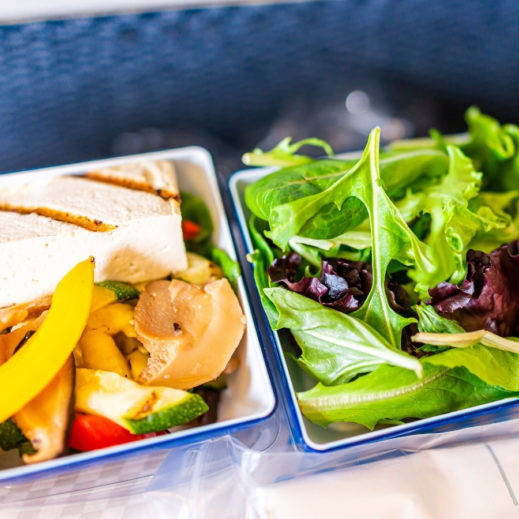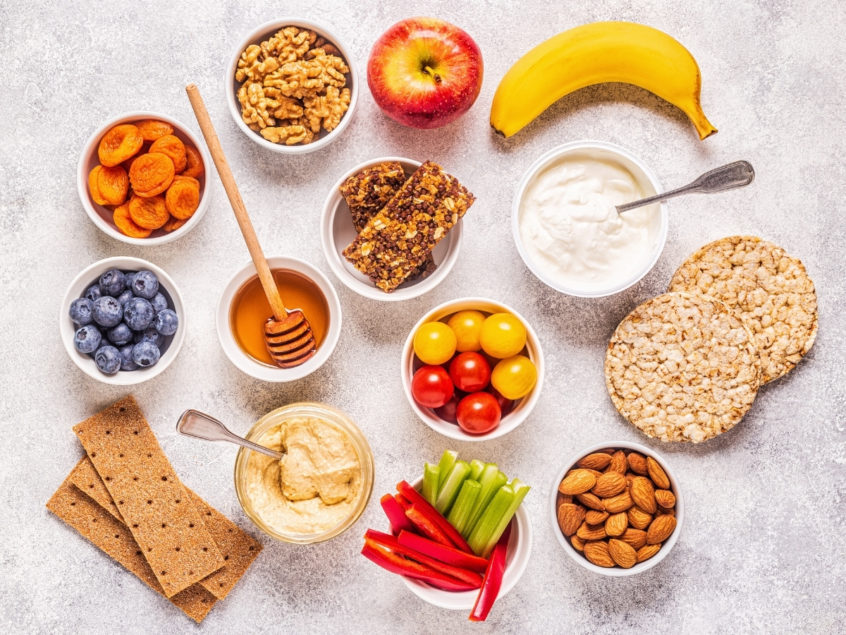Equilibrium
by Circuit

Tips for Traveling and Nutrition: a Sneak Peek of our Virtual Event
08.10.2021
Travel is a common disruption to dietary and exercise routines and an easy way to fall out of the healthy habits, especially for those building a new routine. After returning from a leisure or work trip, it can feel like a step back from all the progress made because exercise is limited or non-existent, dining happens on a whim, and sleep deprivation often happens.
So how can you mitigate the ripple effects of dietary choices while traveling or being on-the-go? Taking a proactive approach rather than a reactive one is the simple adjustment you need that can set you up for success. In a recent virtual event for several of our Circuit communities, we helped residents learn more about how they can take a healthier approach to food choices while traveling. Lauren Thomas has her Masters in Nutritional Education from Columbia University, and has worked in the Performance Nutrition realm for 10 years with active military while also participating in seminars. She has 5 guidelines that offer a healthy approach to traveling. Here are several of the highlights she shared with us:
2. Eating for maintenance and the 80/20 Rule
Before you even depart for your trip, you can start by planning to bring a lot of healthy snacks with you. A reusable water bottle to help you stay hydrated is a great first start, especially since being on a plane requires more water the longer you are on flight. If you feel an onset of hunger come on and you’ve already ate within the last couple of hours, have water first because sometimes you are hungry when you are actually dehydrated and also allows food to properly digest. You want to aim to drink half your body weight in ounces of water per day. In addition to water, bring healthy snacks of course (see an extensive list of specific recommendations at the end of this post). Eating snacks every 3-4 hours is also recommended to help your energy maintenance to help manage blood sugar drops. Things like nutrition bars in particular can be an efficient choice for much needed protein and fiber – and you want to look for options that contain 3 grams of each.
With the 80/20 rule, you actually have room to allow yourself some room to cheat. So if you can stick to healthy meals the 80% of the time, you still have about 20% of wiggle room, or an average of about 4 meals a week where you can allow for a temptation or enjoy a treat.
For quality nutritional energy bars, Lauren recommends looking for brands including Rx bars, Kind bars, and Luna bars to help you feel satiated. Beef jerky provides another option for extra protein, as well as trail mix or nuts such as almonds and cashews. Salmon or tuna packets can also be a great snack to include, since it’s especially easy to get carbs when traveling, but not quality protein. Fresh fruit is always a good option to provide you with some fiber and essential vitamins and minerals that you might miss during your main meals. Combo snacks such as apples and peanut butter, string cheese, carrots, and hummus are great snacks to pack in a cooler for a long drive.
3. Familiarize yourself with the area
If you have a flight, look online a day or two ahead of time at the airport terminal you are scheduled to fly in or out of to see what restaurants are there and try to have a look at their menu so you can be aware of healthy options going into the scene. If you’re driving, look ahead for healthier restaurants in various spots along your route. Check out your lodging and see what they have to offer for breakfast, but also go to the local supermarket and pick up easy items like apples and yogurt or other snacks you can have on hand with you at all times. Try to always look for options that include high protein, fiber, whole grains and colorful foods. Another helpful strategy is if you are at a hotel and they offer a continental breakfast, grab whatever healthy to-go foods you can to save for later such as a banana or a nut/granola bar.
4. Time your food fueling
Ideally, you want to eat every 3-4 hours for stable energy to keep you going. Stay mindful of your hunger and pay attention to when you are full, so you aren’t engaging in over-eating all the time. Food can also impact your circadian rhythm, so it’s best to try and eat with the sunrise/sunset of your new location, and avoid skipping those meals at all possible to help you quickly adapt to the new time zone, if you are in one. Your glucose utilization is better when you’re eating during the hours the sun is up, whereas when the sun goes down, eating foods especially heavy in carbohydrates makes it more work for your body to process and break down.

5. Win at fast food
Sometimes a fast food drive in option is inevitable. The best action here would be to avoid fried or crispy choices to spare on calories and saturated fat. Go for smarter sides, including fruit wherever possible, a baked potato versus fries, or a salad as a few examples. Another recommendation if you still want to go for the junk food is to downsize. If you are craving the fries for instance, get the kid’s size and then choose a healthier option for the rest of your main meal. For buffets, breakfasts, lunches and dinners, the ideal variation of food on your plate should include ½ veggies, ¼ carbs and ¼ protein. The more color you have on your plate the better as well.
Recap of snack recommendations for ever travel scenario
Non-perishable snacks on-the-go:
- trail mix
- roasted edamame or chickpeas
- low sodium jerky
- pre-portioned nuts
- nut butters (travel packs)
- instant oatmeal
- whole grain snack bars (Kind, Kashi, Laranbar, Cliff bar)
Airport terminal snacks:
- part-skim mozzarella cheese stick
- whole wheat sandwich with lean meat, vegetables, and mustard
- salad with lean protein
- vegetable soup
- skim or low fat latte
- fruit cup
- Greek yogurt
- pre-cut veggies and dip
Road trip snacks:
- fresh fruit with skin, pre-cut apple slices or apple sauce, raw veggies, pre-made sandwiches or salads, yogurt, bottled water
- For drive throughs and fast food opt for grilled, steamed or broiled over fried wherever possible, and substitutes like fruit cups
- If you have a craving for something like fries, allow yourself a kids portion or a smaller portion while selecting a healthy main meal
Hotels
- Try to select rooms with a mini-fridge wherever possible, and go to convenience stores or local grocery stores for items like hard boiled eggs, cans of tuna, whole wheat bread, peanut butter, deli meat and yogurt
- Use the coffee maker to heat up water for instant oatmeal
- Take advantage of complimentary breakfast when you can, and grab items like bananas, granola bars or fruit on your way out
- Avoid sugary, baked goods
Healthier gas station choices
- shelled pistachios
- roasted or raw almonds
- beef or turkey jerky
- bananas, apples, oranges, yogurt
- individual hummus and pretzel packs
- part skim string cheese
- granola bars
- snap pea crisps
- sunflower seeds
- celery and/or carrot & dip cups
- granola and nut bars (Kashi, KIND, Cliff bar, RX Bar, Larabar)
- premade turkey and cheese sandwich
- pre hard boiled eggs
- Opt for beverages such as flavored Dasani water, seltzer water, unsweetened ice tea and skim milk
If you’re interested in having fun, unique events like this at your building, reach out to us today!


